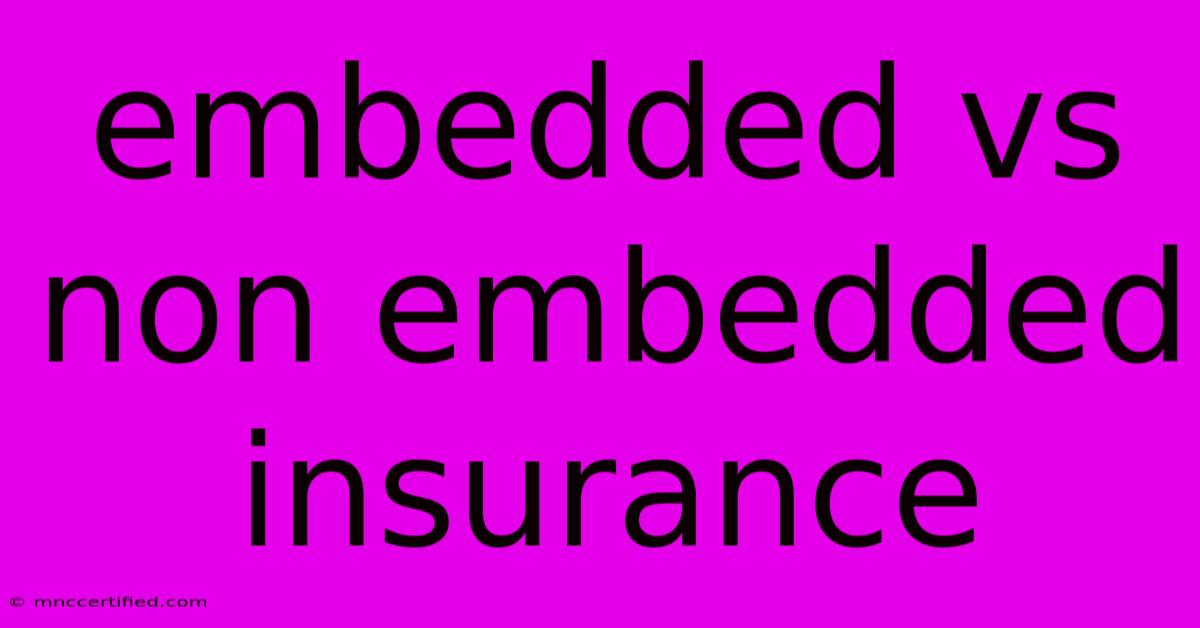Embedded Vs Non Embedded Insurance

Table of Contents
Embedded vs. Non-Embedded Insurance: Which is Right for You?
The insurance industry is undergoing a significant transformation, driven largely by the rise of embedded insurance. But what exactly is embedded insurance, and how does it differ from traditional, non-embedded insurance? Understanding these distinctions is crucial for both consumers and businesses navigating the evolving insurance landscape. This article will delve into the key differences, advantages, and disadvantages of each approach.
What is Embedded Insurance?
Embedded insurance seamlessly integrates insurance products into the purchase journey of another product or service. Instead of buying insurance separately, you acquire it alongside something else – perhaps a new phone, a rental car, or even a subscription service. Think of it as insurance "baked in" to the overall experience. This integration often leverages APIs and digital technologies to streamline the buying process.
Examples of Embedded Insurance:
- Purchasing phone insurance during a smartphone checkout: Many retailers now offer the option to add insurance to your new phone directly in the shopping cart.
- Adding travel insurance when booking a flight: Travel websites frequently provide the opportunity to purchase travel insurance alongside your flight and hotel bookings.
- Securing warranty protection for an appliance at the point of sale: Retailers can bundle extended warranties directly into the purchase of large appliances.
Advantages of Embedded Insurance:
- Increased Convenience: The most significant advantage is convenience. Consumers can purchase insurance at the point of need, without the hassle of separate applications and comparisons.
- Improved Conversion Rates: For businesses offering embedded insurance, this leads to higher conversion rates, as customers are more likely to purchase insurance when it's readily available and integrated into their existing purchase.
- Enhanced Customer Experience: A seamless and integrated experience improves overall customer satisfaction and loyalty.
- Targeted Offerings: Embedded insurance allows for highly targeted and relevant offerings, based on the customer's purchase and risk profile.
- Increased Revenue Streams: For businesses integrating insurance, it presents a new revenue stream and strengthens customer relationships.
Disadvantages of Embedded Insurance:
- Limited Choice: Customers may have less choice in policy features and providers when insurance is embedded.
- Potential for Higher Costs: Embedded insurance might sometimes be more expensive than policies obtained independently due to convenience fees or higher profit margins for the integrating business.
- Lack of Transparency: The specific terms and conditions of the embedded insurance policy might not be as clearly presented as with standalone policies.
- Data Privacy Concerns: The integration process involves sharing customer data, raising potential privacy concerns.
What is Non-Embedded Insurance?
Non-embedded insurance, the traditional approach, involves purchasing insurance policies directly from insurers or through independent agents. This is the method most consumers are familiar with, where you actively seek out and select an insurance policy based on your needs and research.
Advantages of Non-Embedded Insurance:
- Wider Choice: Customers have access to a wider range of policies and providers, allowing for greater comparison and selection.
- Potential for Lower Costs: Competition among insurers can drive down prices, resulting in potentially more affordable policies.
- Greater Transparency: Policy terms and conditions are typically clearly outlined and easily accessible.
Disadvantages of Non-Embedded Insurance:
- Inconvenience: The process of researching, comparing, and purchasing insurance can be time-consuming and complex.
- Lower Conversion Rates: Consumers may be less likely to purchase insurance if the process is cumbersome or requires significant effort.
- Limited Targeting: It's more challenging to target specific customer segments effectively.
Embedded vs. Non-Embedded: The Key Differences Summarized
| Feature | Embedded Insurance | Non-Embedded Insurance |
|---|---|---|
| Purchase Method | Integrated into another product or service purchase | Separate purchase from an insurer or agent |
| Convenience | High | Low |
| Choice | Limited | Wide |
| Cost | Potentially higher | Potentially lower |
| Transparency | Potentially lower | High |
Conclusion: Choosing the Right Approach
Both embedded and non-embedded insurance serve vital roles in the market. The best approach depends on individual needs and priorities. Consumers seeking convenience and streamlined purchasing might prefer embedded insurance, while those prioritizing choice, cost comparison, and transparency may opt for non-embedded options. As technology advances, the lines between these two approaches will likely continue to blur, leading to innovative solutions that benefit both consumers and insurers. The future of insurance is likely to be a blend of both models, offering tailored options to meet diverse customer preferences.

Thank you for visiting our website wich cover about Embedded Vs Non Embedded Insurance. We hope the information provided has been useful to you. Feel free to contact us if you have any questions or need further assistance. See you next time and dont miss to bookmark.
Featured Posts
-
Arkansas Razorbacks Vs Texas Live Updates
Nov 17, 2024
-
Ankle X Ray Cost Without Insurance
Nov 17, 2024
-
Rugby England 20 29 South Africa Review
Nov 17, 2024
-
Insurance Companies In Savannah Ga
Nov 17, 2024
-
Frenectomy Narrative For Insurance
Nov 17, 2024